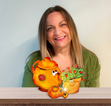Dawn Renee Stephens's Blog, page 6
September 12, 2022
Pentateuch meaning. How to help kids cherish the first five books of the Bible
What is the meaning of the Pentateuch? I was recently asked to write a review for the fruitful book, Pentawhadda by Lynn Calvin Plater.
[image error] [image error]From Westbow Press and CYLS-KIDS comes a book designed to teach children about the first five books of the Bible. In the tradition of Pilgrims’ Progress, the characters’ names have a symbolic meaning. Therefore, the story teaches ambiguously as well as showing examples of explicit instruction.
How to teach the meaning of the Pentateuch.Pentawhadda shares an experience of a class at a Christian school welcoming a guest speaker named Mrs. Bibel. The guest speaker and teacher, Mrs. Prazer, positively collaborate with the students to create a fun learning environment. Likewise, the passages demonstrate fun interactions between a teacher and her students.
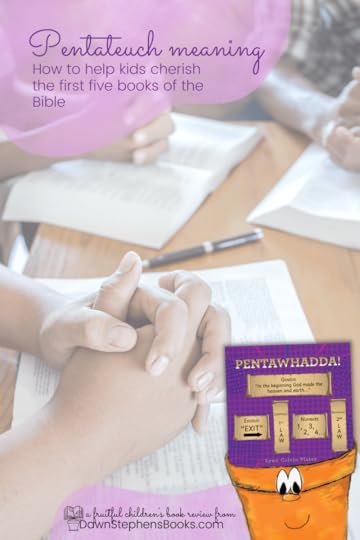 Pentawhadda is a book that helps children learn about the Pentateuch.Pentateuch meaning
Pentawhadda is a book that helps children learn about the Pentateuch.Pentateuch meaningThroughout the text, the reader will discover they are reciting the words aloud. Moreover, Mrs. Bibel’s methods for pronouncing big words stay with you. Pretending to sneeze at the end of the word Pentateuch and saying statements such as “Leave it inside us” for Leviticus make for fun vocabulary lessons. In addition, the detailed illustrations allow the reader to see a diverse classroom filled with visual aesthetics.
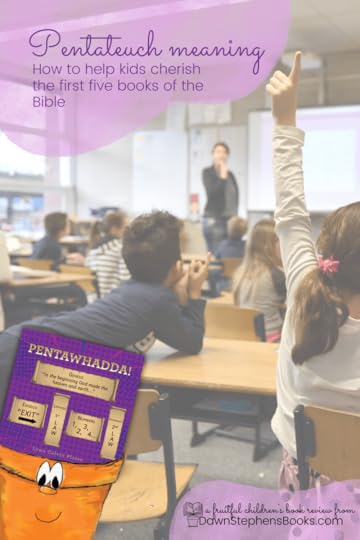 Teaching kids about the first five books of the Bible? Use the book, Pentawhadda by Lynn Calvin Plater.a resource to teach children about the first five books of the Bible
Teaching kids about the first five books of the Bible? Use the book, Pentawhadda by Lynn Calvin Plater.a resource to teach children about the first five books of the BiblePentawhadda is a great resource to teach children about the first five books of the Bible. Having been in the classroom myself, I know that children will identify with the text and will be eager for Mrs. Bibel to visit as the special guest Friday speaker again.
more children’s books to teach Biblical truthsIf you enjoy Pentawhadda, you will also want to check out The Little Pot, The Tea Pot, and The Oil Lamp books. These are vessels that the potter created for a specific purpose. As a result, their stories will inspire you to learn more about God’s Word. Just put in your first name and email below. We will send you the steps to becoming a fruit-bearing vessel just for signing up. In addition, we send fruitful Friday emails with even more stories.
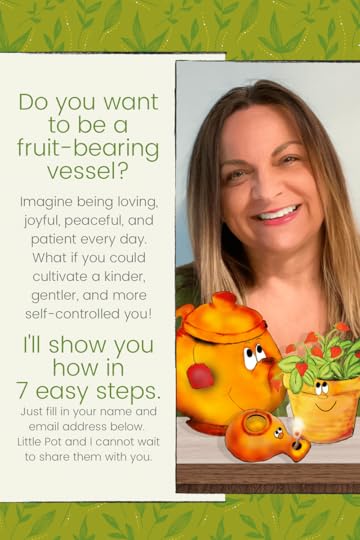 Learn how the potter grows the fruit of the Spirit through you.
Learn how the potter grows the fruit of the Spirit through you.By the way, the Amazon links in this post are “affiliate links”. Subsequently, if you click on them and make a purchase, I will earn a little bit of money. Hopefully, enough people will click on them and I’ll earn a lot of money! That hasn’t happened yet, but a girl can dream, right? In addition, If you do purchase one of my books, please, please, PLEASE write a review for it on Amazon. A positive review has many benefits. It moves the book up in search engines and helps others find it. Consequently, it is one of the nicest things you can do for me. You can also purchase signed copies of the potter books directly from me in the website store.
If you prefer to buy the entire set as a signed copy, go here. In addition, if you would like to schedule Dawn for a speaking engagement or author visit, go here.
The post Pentateuch meaning. How to help kids cherish the first five books of the Bible appeared first on Inspirational Children’s Books & Creative Teacher Resources.
September 5, 2022
Biblical Integration with Children’s Books, 3 inspiring ideas for Harry, the Dirty Dog
Biblical integration can be done through any story. I love helping children discover spiritual truths in children’s literature. God is the author of the story. Therefore, regardless of the intent of the author, Christ can be found within the plot of any book. You can read more about story writing here.
I used to have a little white dog with black spots. Therefore, one of my favorite stories as a child was Harry, the Dirty Dog by Gene Zion and Margaret Bloy Graham.
a summary of the storyHarry is a very happy dog except for one thing. He hates baths. He hates baths so much that he buries the scrub bush in the yard and then runs away from home. While away, he has a lot of fun exploring new roads, railroads, and coal chutes. His adventures cause him to get very dirty. Eventually, he is no longer a white dog with black spots. He is now a black dog with white spots.
Harry misses his family and wonders if they know that he has run away. Therefore, he returns home. However, his family does not recognize him. Harry tries to show them who he is. Just when it seems he’ll never be able to convince them, he remembers the scrub brush he buried. He digs it up and runs to the bathtub. When his family washes this stray puppy, they realize that it is Harry after all. Here are a few great teaching tips to use with this book.
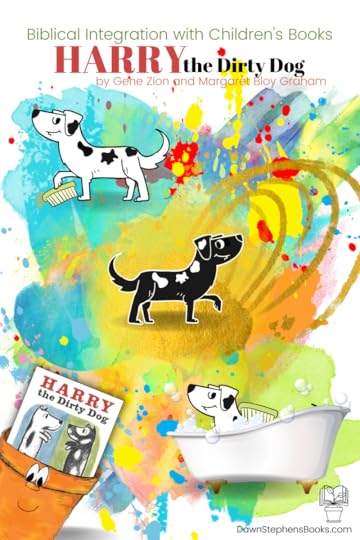 Harry, the dog runs away. Then becomes dirty. Eventually, he returns home for his bath.biblical integration, when we feel like running
Harry, the dog runs away. Then becomes dirty. Eventually, he returns home for his bath.biblical integration, when we feel like runningHarry is not the only one who runs from the things that he does not like. How often do you and I do the same? There may be things that we know are good for us, but they make us uncomfortable. Therefore, we avoid them just like Harry avoids taking a bath.
In Luke 15:11-32, Jesus tells us a story about a son who ran away. He has fun with his friends for a time. However, he runs out of money and misses his family just like Harry. He decides to return home as a servant instead of a son. However, unlike Harry, his father recognizes him immediately. He welcomes him home, hugs him, and does not make him a servant. This story illustrates how when we leave or wander away from our heavenly father, He welcomes us home with open arms. God knows us and loves us. He welcomes us into His family.
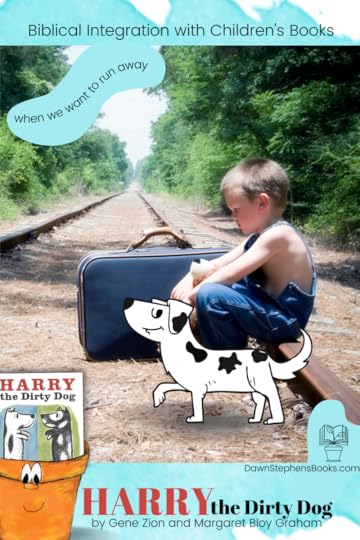 We all feel like running away at times. Just like Harry, we run away from the things that do not feel good to us.biblical integration, getting dirty
We all feel like running away at times. Just like Harry, we run away from the things that do not feel good to us.biblical integration, getting dirtyHarry gets dirty on his adventures. Likewise, when we travel away from God, we become “dirty” too. Sin is compared to wearing filthy rags in Isaiah 64:6. The Bible says that we are unclean because we sin. In Ephesians 5:27, Paul further illustrates this point by describing how Christ loves the church and removes the blemishes and spots from us. Therefore, if our sin is represented by dirt, we can relate to Harry when the dirt made him unrecognizable. Our sin will turn us into someone we do not want to be. Therefore, the next idea of biblical integration is that Harry needs a bath.
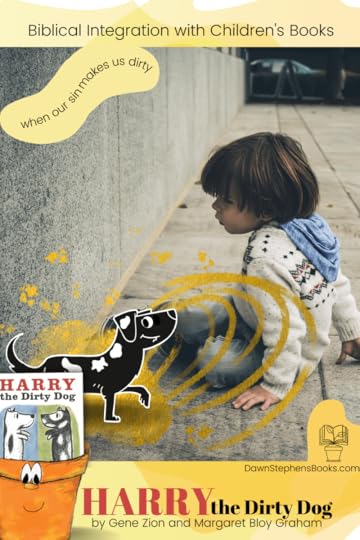 When we sin, we are left feeling dirty, alone, and sad. Like Harry we miss home.integrating biblical truths with washing off the dirt
When we sin, we are left feeling dirty, alone, and sad. Like Harry we miss home.integrating biblical truths with washing off the dirtHarry needed a bath. Since the Bible describes our sins as dirt and something that needs to be washed away, we can continue to learn biblical truths. The Tea Pot picture book also uses this illustration. You can read more about God washing away our sins here. In Psalm 51:7, David asks God to remove his sins and wash him so that he is as white as the snow. The New Testament speaks of washing our sins away too. Paul is told by Ananias to be baptized and wash away his sins (Acts 22:16). Everyone needs this washing. We all have sinned (Romans 3:23).
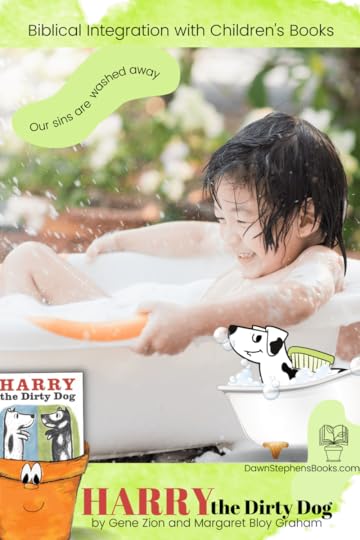 The Bible explains that Jesus washes our sins away.
The Bible explains that Jesus washes our sins away. I hope this post gave you ideas on how biblical truths can be integrated in children’s books. Corduroy by Don Freeman is also a book I have used to share the gospel. You can read that post here.
more biblical truths integrated through storiesLet’s continue the conversation. In my children’s books, you’ll discover how each of the potter’s vessels has a story full of biblical integrations too. Just put in your first name and email below. We will send you the steps to becoming a fruit-bearing vessel just for signing up. I promise you’ll be inspired. In addition, we send fruitful Friday emails with even more stories.
 Learn how the potter grows the fruit of the Spirit through you.
Learn how the potter grows the fruit of the Spirit through you.By the way, the Amazon links in this post are “affiliate links”. That means that if you click on them and make a purchase, I’ll earn a little bit of money. Hopefully, enough people will click on them and I’ll earn a lot of money! That hasn’t happened yet, but hey, a girl can dream, right? In addition, If you do purchase one of my books, please, please, PLEASE write a review for it on Amazon. A positive review has many benefits. It moves the book up in search engines and helps others find it. Consequently, it is one of the nicest things you can do for me. You can also purchase signed copies of the potter books directly from me in the website store.
If you prefer to buy the entire set as a signed copy, go here. If you would like to schedule Dawn for a speaking engagement or author visit, go here.
The post Biblical Integration with Children’s Books, 3 inspiring ideas for Harry, the Dirty Dog appeared first on Inspirational Children’s Books & Creative Teacher Resources.
August 29, 2022
The Little Pot – What is it? How a Compassionate Potter uses it.
The Little Pot is an inspirational story teaching the value of patience and the loving omniscience of our Creator. Here’s what makes it so special!
the little pot is a one-of-a-kind vessel made by a potterIn the stories about the Little Pot, the potter makes vessels one at a time. He forms them and creates them with his hands. In the biblical account of creation, God spoke everything into existence until He made humans. He then used his hands to form man from the clay of the earth. Our creator also forms us. We are each created as unique and different individuals. There is no one else like you.
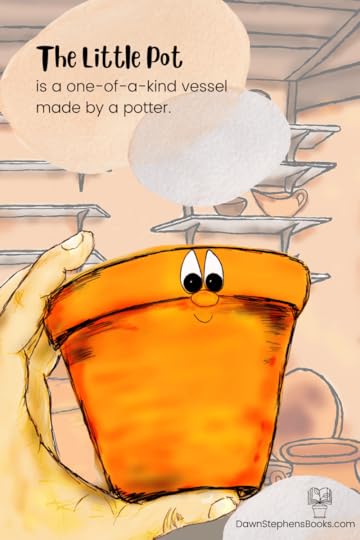 There is no other vessel like you. The potter made you unique and special.a little vessel with a big job
There is no other vessel like you. The potter made you unique and special.a little vessel with a big jobThe Little Pot is then given work. It has the job of holding things for the potter. Once God created man, He put him in a garden to work it (Gen. 2:15). We were created for good works too (Eph. 2:10). In the story the little pot holds papers which makes it feel very smart. It also holds coins which makes it feel rich. However, the potter gives items and takes them away (Job 1:21).
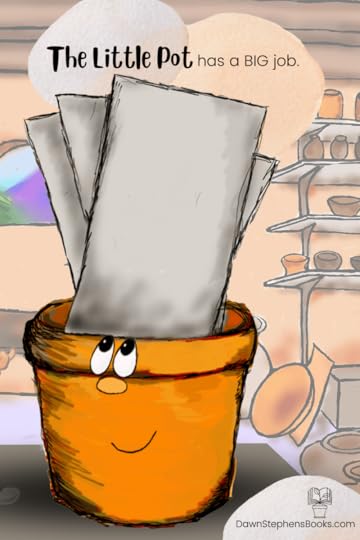 We often think what the potter gives us to hold is what’s important. a little pot that is empty
We often think what the potter gives us to hold is what’s important. a little pot that is emptyWe sometimes feel full and content with our lives. However, that only happens sometimes. Other times we feel empty or as if we need something more. That emptiness makes us wonder what we are missing and we then try to fill ourselves with a lot of different things. The potter, himself may take things out of our lives too. He is the one that can fill our hearts, souls, and minds like nothing else (Eph. 3:19).
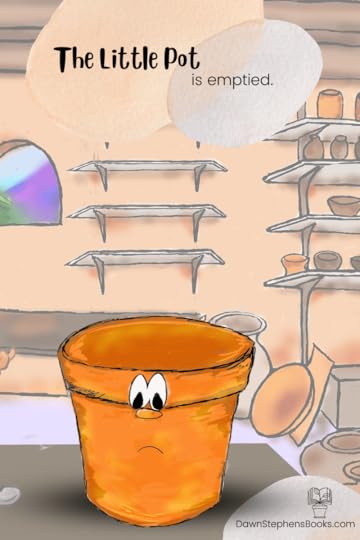 The potter sometimes empties us.a little pot can grow more than it can hold
The potter sometimes empties us.a little pot can grow more than it can holdWhen we allow Christ to fill us, His spirit produces fruit. This fruit is love, joy, peace, patience, kindness, goodness, faithfulness, gentleness, and self-control (Gal. 5:22-23). When we use that fruit for others, more and more grows until it overflows (Matt.25:29, Luke 6:38).
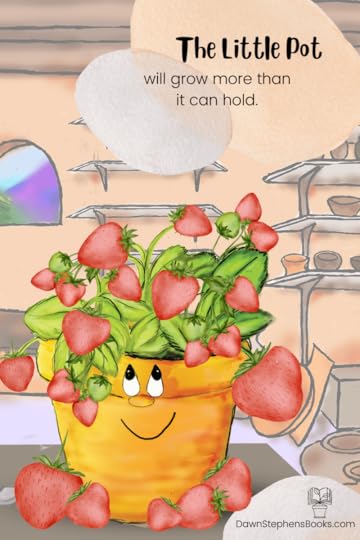 The little pot grows fruit. the little pot is a book full of timeless truths
The little pot grows fruit. the little pot is a book full of timeless truthsThe Little Pot book is special because it contains so many truths from God’s word. There is not just one lesson we can learn from it. I love how young children enjoy the storyline. In addition, I love how adults identify with the vessel and see themselves within this simple story. It’s been over ten years since The Little Pot was first written and I find myself still drawing from the truths within its pages.
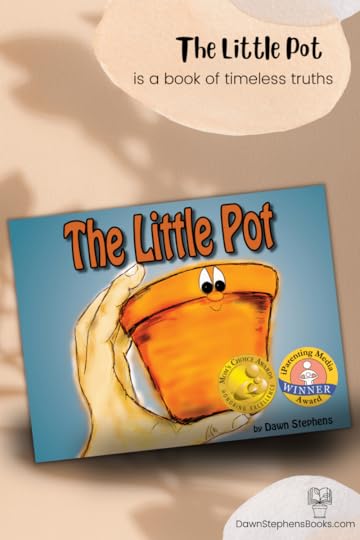 The book is full of timeless truths.keep growing with me
The book is full of timeless truths.keep growing with meLet’s continue to grow it together. You’ll discover how each of the potter’s vessels has a similar story too. Just put in your first name and email below so we can send you the steps to becoming a fruit-bearing vessel. I promise you’ll be inspired to keep following Christ. In addition, we send fruitful Friday emails with even more stories.
 Learn how the potter grows the fruit of the Spirit through you.
Learn how the potter grows the fruit of the Spirit through you.You can purchase signed copies of these books from our store. The books are also available on Amazon.
If you prefer to buy the entire set as a signed copy, go here. If you would like to schedule Dawn for a speaking engagement or author visit, go here.
The post The Little Pot – What is it? How a Compassionate Potter uses it. appeared first on Inspirational Children’s Books & Creative Teacher Resources.
August 22, 2022
Tell your stories, four powerful examples of testimonies in the Bible
Did you know the Bible commands you to tell your stories? Psalm 107:2 says “Let the redeemed of the Lord tell their story”. The cool thing about this commandment is that God just doesn’t just tell us to do it. He also shows us how. I recently posted a blog and resources about how to write a fruitful story. Then on Sunday, my pastor gave a sermon from Psalm 107. Therefore, I thought this week it would be fun to look at the examples God gives us from this text and see how they fit our fruitful story descriptions. It will also help you write your testimony and do as God says, tell your story!
testimony defineI think we sometimes become overwhelmed with the idea of sharing our testimony. However, it should be fairly simple. The Word of God says if you are “redeemed of the Lord” you should tell your stories. Therefore, we need to understand redemption. Redeemed means to be compensated for something bad. The bad in us and in our world leads to death and separation from God. (Romans 6:23). Consequently, Christ had to die to pay for it all. His death is the compensation that redeems us.
This verse, however, does not say that you are to tell THE story. Instead, it says you are to tell YOUR story! That is because Christ’s redemption can manifest itself differently in each of our lives. That is what makes your story unique and special. Psalm 107 goes on to give four examples.
tell your stories as the wanderer The first testimony example is from Psalm 107: 4-9, the wanderer
The first testimony example is from Psalm 107: 4-9, the wandererIn verses four through nine, the text speaks of those that wandered in desert wastelands, finding no city where they could settle. They were hungry and thirsty. Then, they cried out to God and He led them to a city where they could settle. Being lost physically and without food or water is hard to imagine. However, you might know what it feels like to be lost emotionally. I know I do. There have been times in my life when I’ve wondered which path I should take. Also, there have been times when I know I took the wrong path, and then I wandered around with regret.
If you feel like you are wandering through life without purpose, then this might be where your testimony begins. I challenge you to become hungry and thirsty enough for the clarity and direction that can only come through a relationship with Jesus. Call out to Him, follow Him, and then watch Him lead you to a place where you feel settled and safe. Once you do, your testimony or story will be about how you felt lost until God gave you direction and set you on the right path in life.
If you don’t follow Jesus as a wanderer, you may up as the prisoner.
the prisoner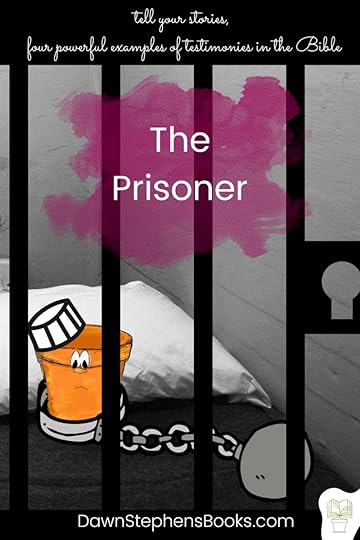 The second testimony example is from Psalm 107:10-16, the prisoner.
The second testimony example is from Psalm 107:10-16, the prisoner.Next, in verses ten through sixteen, the text describes a prisoner in utter darkness and iron chains. When I think of chains, I think about addictions. Our addictions are definitely things that keep us in the dark and from being free. We have all at some point rebelled against God’s word and did not like His plans. We may have known the way we should live, but for some reason or another, we chose a different path. After being taught right from wrong, we got older and decided that our own way made more sense. Therefore, we stopped wandering and chose certain things that we now control us. We feel we cannot stop them. Consequently, things haven’t worked out for the best. The verses describe this person as being subjected to bitter labor, stumbling, and alone. I know the times I chose my path over God’s, it led me to feel exactly like that.
Again, however, when a person in this situation cries out to the Lord, He saves them from their distress (vs. 13). He brings them out of the darkness and breaks the chains of whatever addiction is imprisoning them. If you relate to this example, them this might be a part of the story you tell.
If we still do not allow Him to save us at his level, our addictions can make us very sick.
tell your stories when sick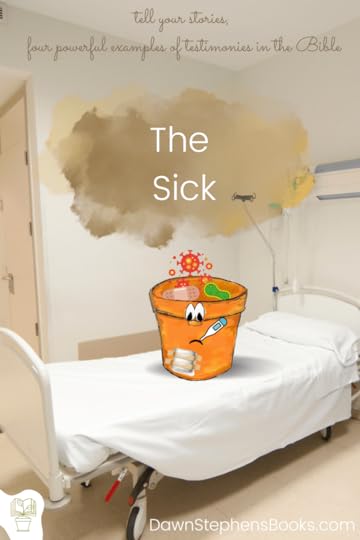 The third testimony example is from psalm 107:17-22, the sick
The third testimony example is from psalm 107:17-22, the sickThirdly, verse 17-22 are about the sick or injured. These verses tell us that our continued rebellion toward God will lead to illness where we no longer have an appetite for food and are close to death. Once again, however, if this person cries to the Lord in their trouble, He saves them from distress, heals them, and rescues them from the grave.
In all three of these examples, God saves us from ourselves and the mess that we can make of our own lives. The fourth example, however, describes how God continues to rescue us whenever our circumstances keep us from sailing through this life.
the sailor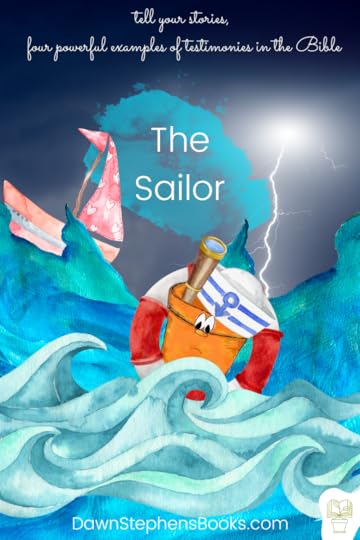 The fourth testimony example is from psalm 107:23-32, the sailor
The fourth testimony example is from psalm 107:23-32, the sailorIn the fourth section of the text, verses 23-32, we see the example of a sailor. This person is not rebelling. They are just going about their daily work as merchants do. However, they end up on mighty waters where they see God’s power. In this situation, they loose courage and discover that their own skills or wits are not enough to sustain them. They too cry out to the Lord and He stills the storm around them and then guides them to safety. You might find that your story has you in a situation that you did not create. You’re where you are because of situations that were completely out of your own control. You still need to call out to Christ. He completes your story.
how to tell your storiesIn our story writing curriculum, we teach that the main character must have an obvious and a hidden need. The events of the story lead that character to a climax where they fight for the obvious need and inadvertantly have their hidden need met. If you have not yet read that post, please do. Then, as you tell stories of how Christ redeemed you, you’ll find these same elements.
The wanderer’s obviously lost and hungry. When following Christ, the obvious need is met. Then, a deeper, hidden need for direction and purpose is found too.
The prisoner’s obvious need is freedom from an addiction. When choosing Jesus over the addictive substance, ine obviously gains freedom. In addition, the hidden need which originally led to that substance is also satisfied in Christ.
When sick, an obvious need is restoring appetite and health. Finding Christ also restores a spiritual appetite and gives us eternal life.
The sailor’s obvious need is to be rescued from the stormy situations. Hiddenly, he gains courage when new storms arise.
I hope you can see how your stories include wandering, imprisonment, sickness, and sailing through storms too. On the otherside of it all is Jesus. He is the unexpected suprise that blooms and causes us to be fruitful.
keep your story growingNow that you have an idea of how to tell your story, Let’s continue to grow it together. You’ll discover how each of the potter’s vessels have a similar story too. Just put in your first name and email below so we can send you the steps to becoming a fruit-bearing vessel. I promise you’ll be inspried to keep following Christ. In addition, we send fruitful Friday emails with even more stories.
 Learn how the potter grows the fruit of the Spirit through you.
Learn how the potter grows the fruit of the Spirit through you.You can purchase signed copies of these books from our store. The books are also available on Amazon.
If you prefer to buy the entire set as a signed copy, go here. If you would like to schedule Dawn for a speaking engagement or author visit, go here.
The post Tell your stories, four powerful examples of testimonies in the Bible appeared first on Inspirational Children’s Books & Creative Teacher Resources.
August 15, 2022
8 Lyrics of Nursery Rhymes that teach all year long (part 2)
Lyrics of nursery rhymes are a great way to teach young children to read. The rhyme and rhythm within these short poems are easy for children to remember as they track a written text. Some lyrics of nursery rhymes, however, are not relative to a child’s world today. Therefore, we have recreated eight traditional rhyme lyrics so they teach math and science concepts as well as reading skills.
These new nursery rhyme lyrics have been written and illustrated in a series of printable guided reading books. For fun, we have titled the series, Mother Goose Meets Mother Nature. Next, we developed a Teacher’s Guide to go along with each book. Finally, we organized the series in a way that we felt teachers could use one each month. We have paired them with themes you might already be teaching throughout the year. The resources for September through January can be found in part one of this blog here. The entire series can be purchased at our Teachers Pay Teachers store.
Lyrics to Nursery Rhymes in February.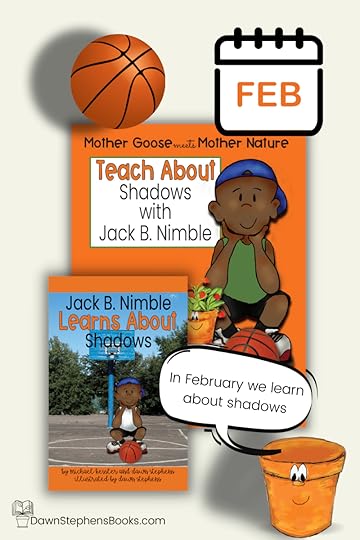 This Jack Be Nimble nursery rhyme is great for February
This Jack Be Nimble nursery rhyme is great for FebruaryIn this version of Jack Be Nimble, he is not jumping over a candlestick. Instead, he is attempting to jump over his shadow. With groundhog’s day in February and basketball season at its prime, it is the perfect time to introduce this creative teaching resource. These lyrics of nursery rhymes will provide reading and writing practice while teaching children the science of how shadows are formed.
Mary had a Little Lamb in March.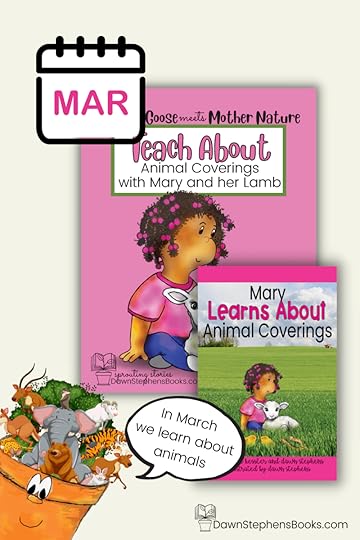 Mary had a Little Lamb are great lyrics of nursery rhymes for March.
Mary had a Little Lamb are great lyrics of nursery rhymes for March.March is a great time to learn about animals. Understanding what animals need in their different habitats is an important objective in early childhood. children love studying different animals and discovering how unique each of them is. In the lyrics of this nursery rhyme, Mary has a little lamb whose fleece is white. She also has other animals with different types of coverings.
When you read this creative teaching resource with your children, they will learn about fur, feathers, scales, and skin. The teacher’s guide will provide you with activities for sorting different animals and locating where they live in the world. There are also opportunities to use math and writing skills.
Lyrics to Nursery Rhymes in April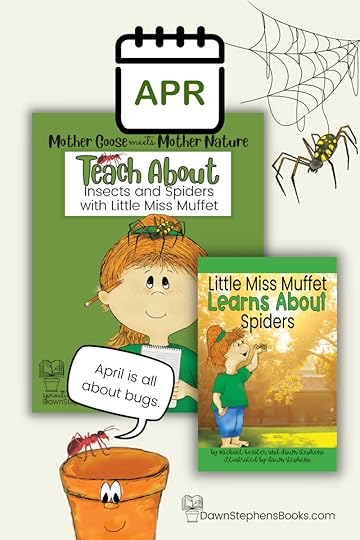 Children can learn the lyrics of Little Miss Muffet in April.
Children can learn the lyrics of Little Miss Muffet in April.When studying animals, we cannot forget about bugs. Many children think spiders and insects are the same. However, their differences help young children learn important scientific concepts. In these lyrics of nursery rhymes, Little Miss Muffet has studied spiders and therefore, is no longer afraid of them. As children read these lyrics, they will study spiders and insects too. The teacher’s guide will provide activities to check their understanding and make learning about these creatures fun.
Humpty Dumpty Lyrics for May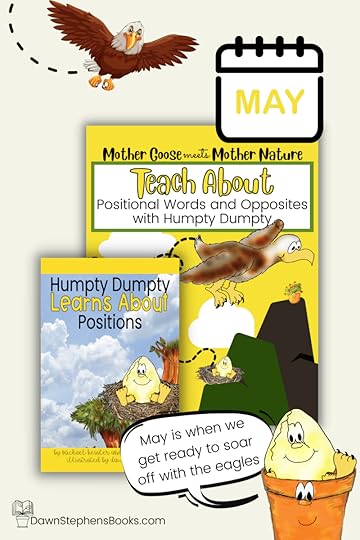 These Humpty Dumpty lyrics teach about positional words and opposites.
These Humpty Dumpty lyrics teach about positional words and opposites.Humpty Dumpty is not just any old egg. He is an eagle egg. In these lyrics, he breaks out and flies above, below, and around. Learning positional words and opposites is another important concept. In addition, as May arrives, children are getting ready to graduate and soar into a new year of learning. These lyrics to Humpty Dumpty will encourage children to try their best and not compare themselves with others.
The first four lyrics of nursery rhymes for the beginning of the school year (September through December) are in part 1 of this blog. Subscribe to the blog and our email list below to never miss a post. As a bonus, you’ll get Little Pot’s seven steps to becoming a fruit-bearing vessel.
Be a fruit-bearing vessel with Little Pot.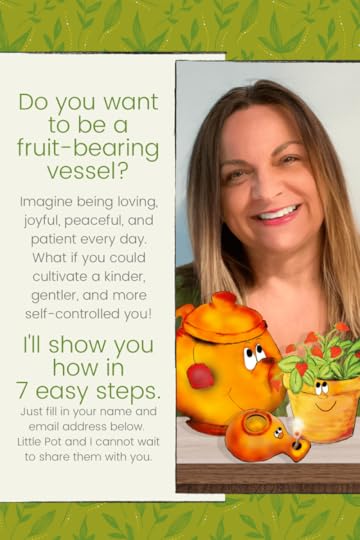 Learn how the potter grows the fruit of the Spirit through you. Being a fruit-bearing vessel is not as easy as reading a children’s picture book. That is why Litle Pot and I have come up with a seven-step process that will allow the potter to grow love, joy, peace, patience, kindness, goodness, faithfulness, and self-control through you. Just put in your first name and email so we can send you those seven steps. Then you’ll get a fruitful Friday email each week with ways to be even more fruitful!
Learn how the potter grows the fruit of the Spirit through you. Being a fruit-bearing vessel is not as easy as reading a children’s picture book. That is why Litle Pot and I have come up with a seven-step process that will allow the potter to grow love, joy, peace, patience, kindness, goodness, faithfulness, and self-control through you. Just put in your first name and email so we can send you those seven steps. Then you’ll get a fruitful Friday email each week with ways to be even more fruitful!The post 8 Lyrics of Nursery Rhymes that teach all year long (part 2) appeared first on Inspirational Children’s Books & Creative Teacher Resources.
August 8, 2022
8 Lyrics to Nursery Rhymes that teach all year long (part 1)
Lyrics to nursery rhymes are a great way to teach young children to read. The rhyme and rhythm of these short poems are easy for children to remember as they track a written text. Some lyrics to nursery rhymes, however, are not relative to a child’s world today. Therefore, we have recreated eight traditional rhyme lyrics so they teach math and science concepts as well as reading skills.
These new nursery rhyme lyrics have been written and illustrated in a series of printable guided reading books. For fun, we have titled the series, Mother Goose Meets Mother Nature. Next, we developed a Teacher’s Guide to go along with each book. Finally, we organized the series in a way that we felt teachers could use one each month. We have paired them with themes you might already be teaching throughout the year. Let’s begin with September.
Lyrics to Nursery Rhymes in Sept.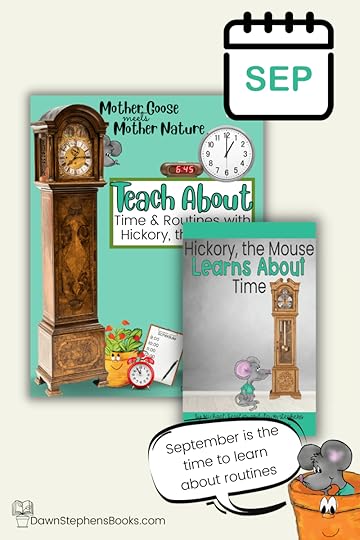 September is when the lyrics to Hickory Dickory Dock teach about school routines
September is when the lyrics to Hickory Dickory Dock teach about school routinesThe lyrics to Hickory Dickory Dock are about a mouse who runs up a clock. The lyrics in our version help students to a learn about time, schedules, and routines. In the printable guided reading book and PowerPoint flipbook, Hickory, the Mouse goes through a typical kindergarten or first grade schedule. Each hour of the clock leads Hickory through another activity of the day.
Because school is beginning the month of September, we felt it was a great time for children to learn the importance of following a schedule and completing classroom routines. Hickory’s schedule consists of hour long intervals so that young children can begin to understand time to the hour and how it progresses. We realize that an hour is a long period of time for one activity when you are young. Therefore, we recommend you also fill the hour with small routine tasks. By the end of September your students are pretty comfortable with their new school routine. Then comes October. And this is the month of pumpkins.
Peter the Pumpkin Eater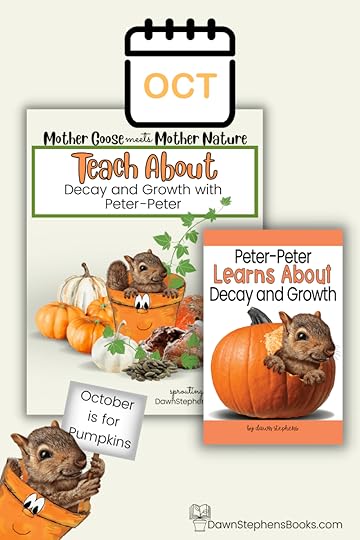 Peter the Pumpkin Eater is a great way for children to learn about decay and growth.
Peter the Pumpkin Eater is a great way for children to learn about decay and growth.We know October is the month for pumpkins. Therefore, we thought there was no better nursery rhyme lyrics than Peter Peter, Pumpkin Eater. the original lyrics of Peter keeping his wife in pumpkin shell probably have a not-so-good back story. However, our lyrics are easier to understand and teach students about decay and growth. You see, Peter-Peter is a squirrel who loves to eat pumpkins. He loves pumpkins so much that he wants to live in one! That’s why he puts his wife inside the shell of a pumpkin. He is “keeping” her well because he is giving her a home made of his favorite food.
As the nursery rhymes lyrics progress, however, Peter-Peter realizes that it may not have been such a great idea. The pumpkin rots and decays. Therefore, Peter and his wife learn the life cycle of a pumpkin. While decay keeps a pumpkin from making a good house, it is an important part of growing new pumpkins. In conclusion, the squirrels have learned an important scientific concept. They also know how to grow more pumpkins to eat.
Lyrics to Nursery Rhymes in Nov.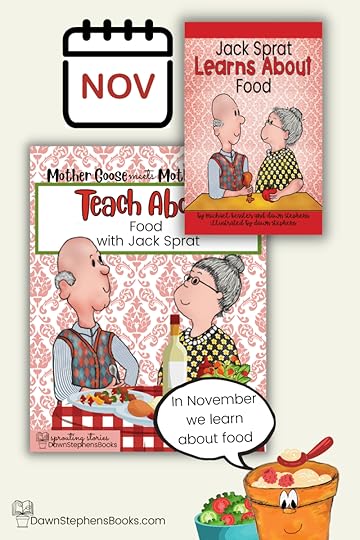 Jack Sprat and his wife can teach students all about healthy eating.
Jack Sprat and his wife can teach students all about healthy eating.Speaking of eating, it is now November. This is the month we enjoy Thanksgiving and Friendsgiving Feasts! Consequently, we feel is a great time to learn about healthy eating and read some new nursery rhyme lyrics for Jack Sprat. You see, Jack Sprat would not eat fat. That is to say he does eat the best part of the meat. His wife, however, will not even eat lean meat. She is what we call a vegetarian. Jack helps his wife by introducing her to other forms of protein through nuts and beans.
In the Jack Sprat teachers guide, we provided activities using resources and graphics from my plate.gov. This website is a great tool when learning to eat healthier.
Since December is a short month in school, we decided to put our next nursery rhyme in January. It’s perfect as the children watch the weather turning colder. Temperature affects a lot of thing including water.
Jack and Jill Lyrics for Jan.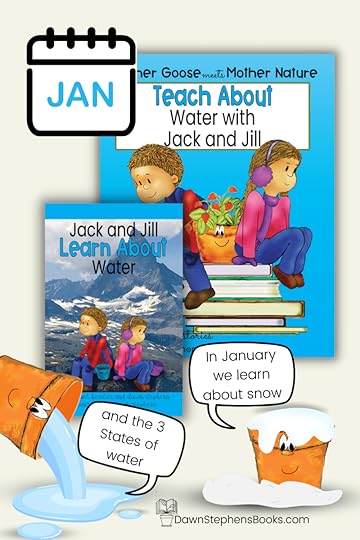 Jack and Jill Learn about Water make great lessons in January.
Jack and Jill Learn about Water make great lessons in January.In these lyrics, Jack and Jill go up a very big hill and instead of fetching a pail of water, they gather snow. Consequently, they learn about the three states of water on their journey. January is a fun month to learn about snow, weather, and temperatures. It is a great time for students to discover how temperature changes things including the state of water.
We will explore the next four lyrics to nursery rhymes for February, March, April, and May in part 2 of this blog. Subscribe to the blog and our email list below. As a bonus, you’ll get Little Pot’s seven steps to become a fruit-bearing vessel.
Be a fruit-bearing vessel with Little Pot. Learn how the potter grows the fruit of the Spirit through you. Being a fruit-bearing vessel is not as easy as reading a children’s picture book. That is why Litle Pot and I have come up with a seven-step process that will allow the potter to grow love, joy, peace, patience, kindness, goodness, faithfulness, and self-control through you. Just put in your first name and email so we can send you those seven steps. Then you’ll get a fruitful Friday email each week with ways to be even more fruitful!
Learn how the potter grows the fruit of the Spirit through you. Being a fruit-bearing vessel is not as easy as reading a children’s picture book. That is why Litle Pot and I have come up with a seven-step process that will allow the potter to grow love, joy, peace, patience, kindness, goodness, faithfulness, and self-control through you. Just put in your first name and email so we can send you those seven steps. Then you’ll get a fruitful Friday email each week with ways to be even more fruitful!The post 8 Lyrics to Nursery Rhymes that teach all year long (part 1) appeared first on Inspirational Children’s Books & Creative Teacher Resources.
August 1, 2022
How to Teach Kindergarten Schedules with a Cheerful Nursery Rhyme
Kindergarten schedules are important in a child’s learning. It is no secret that children do better with a consistent routine. Having a kindergarten schedule allows children to feel safe in the classroom. When they know what is coming next, they have less anxiety and will perform more efficiently. Therefore, as we get ready to head back to school, make time to teach a healthy kindergarten routine.
As you set up your classroom, make sure you display the clock in an easy to see place. Likewise, having clock images on display and set to the event times time will teach students to read the time correctly. Exposure to a world of clocks can teach students to tell time.
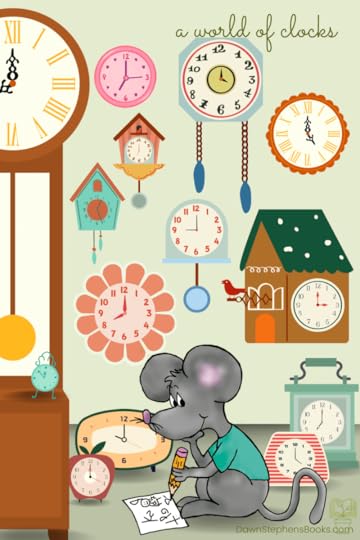 Having clocks around the classroom help students understand how routines and time intervals are measured.Kindergarten Schedules with Hickory Dickory Dock
Having clocks around the classroom help students understand how routines and time intervals are measured.Kindergarten Schedules with Hickory Dickory DockHickory Dickory Dock is a great way for children to learn about time, schedules, and routines. In the printable guided reading book and PowerPoint flipbook, Hickory, the Mouse goes through a typical kindergarten schedule. Each hour of the clock leads Hickory through another activity of the day. Using this creative teaching resource, children will learn to use the clock and the skill of telling time to manage their day.
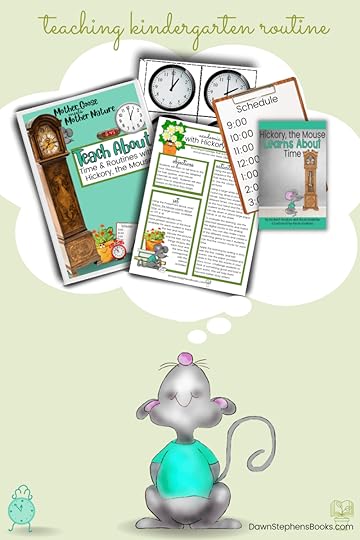 kindergarten schedules can be taught with these resources by Dawn Stephens Books. The Hickory Dickory Dock book and teacher’s guide take children through a day in Hickory’s life.Kindergarten Time
kindergarten schedules can be taught with these resources by Dawn Stephens Books. The Hickory Dickory Dock book and teacher’s guide take children through a day in Hickory’s life.Kindergarten TimeYoung children have little concept of time. You can read more about their understanding of time here. By providing a list of the things they will do each day, however, they can gain a sense of security by learning that time is predictable. Hickory’s schedule is based on time to the hour. Within the hourly schedule, you can list shorter routines to provide even more clarity to your students. For example, Hickory’s routine may include getting dressed, brushing his hair, and making his bed all between seven and eight am. Between breakfast and school starting, Hickory’s routine might include brushing his teet, packing his backpack, and catching the bus. Likewise, his routine might include morning meeting, lunch count, and morning tubs between nine and ten o’clock.
Having one activity each hour, however, will help your kindergarten schedules teach students to tell time. Having shorter intervals of a routine each hour will help children accomplish more each day.
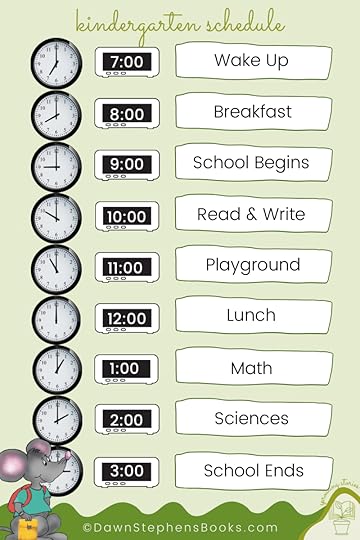 Hickory’s kindergarten schedule teaches children about time to the hour.
Hickory’s kindergarten schedule teaches children about time to the hour.You can create a clock schedule for your child or download a FREE one here.
Purchase the guided reading book here.
Purchaste the teacher’s guide here.
Or, buy both for a discounted bundle price here.
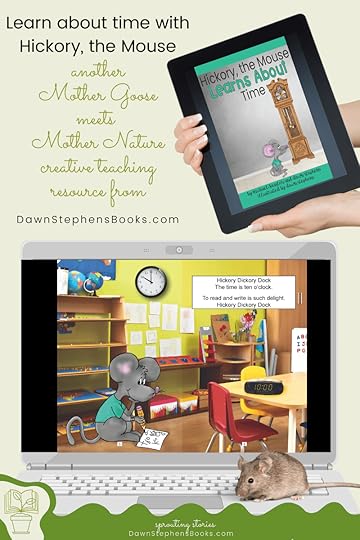
The post How to Teach Kindergarten Schedules with a Cheerful Nursery Rhyme appeared first on Inspirational Children’s Books & Creative Teacher Resources.
July 25, 2022
How Elements of the Story Grow like Little Pot
The elements of the story can be easily remembered if you compare them to how a plant grows. If you follow these steps and include the elements, you’ll write great stories that grow in the hearts of your readers. In addition, you can purchase resources that encompass these ideas here from the TPT store.
Elements of the story are like plantsA little clay pot will illustrate the process. Little Pot is a vessel created by the potter for the purpose of bearing fruit. The story of The Little Pot includes different parts of a story too. You can purchase the picture book here.
Stories have many parts just like plants. Plants are all different. Some are long and tall. Others are short and bright. They can be prickly, sharp, colorful, and fragrant. Even though plants look, smell, and feel different, they all require the same things to grow. Likewise, your writing will require elements to grow into a great story. We will be comparing the following seven elements.
Different parts of a storySettingThe main character with obvious and hidden needsInciting IncidentRising action with two-fold eventsClimaxUnexpected SurpriseConclusion and a fruitful lesson The settingThe soil and pot is the place where a plant can grow. Likewise, the setting is the place your story will grow. Consider the time, place, mood, culture, and climate. Then describe the setting.
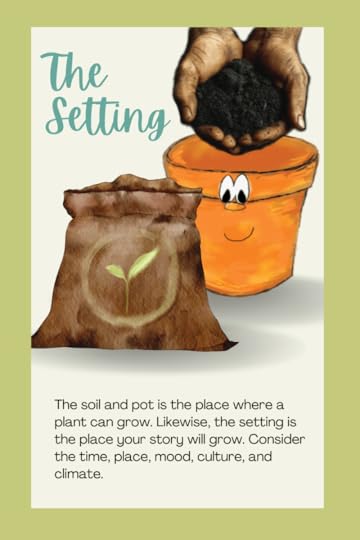 Think of the setting as soil where you will plant and grow your story.The main character with obvious and hidden needs
Think of the setting as soil where you will plant and grow your story.The main character with obvious and hidden needsThe main character is the seed planted in the setting (soil). It must have an obvious need (water) and a hidden need (sunlight). Just as farmers plant many seeds, your story will have many characters. However, the main character is the one that should have an obvious and hidden need. The obvious need is clear and visible like water. However, the character may not even be aware of their hidden need. The effects of this need are simply felt during the story. It is not something your reader will look directly at. Therefore, it should be something emotional or spiritual. Likewise, it is something that everyone needs and will make your reader identify with your character.
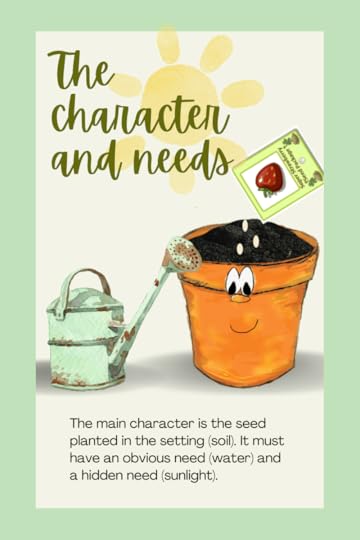 The main character is like a seed planted in the setting or soil. it should have an obvious and a hidden needlesson 3: your faith is more important than your works
The main character is like a seed planted in the setting or soil. it should have an obvious and a hidden needlesson 3: your faith is more important than your worksSomething happens…
Inside the pot, buried in the soil, the seed breaks open, and new roots begin to form, upsetting the seed’s world. Then, a stem climbs and grows upward. In your story, this is the moment where something happens to the main character. A new event occurs that upsets the balance within the main character’s world. It should be esciting and gran the attention of your reader. This new journey will climb and grow throughout the narrative. The rising action of the story has begun.
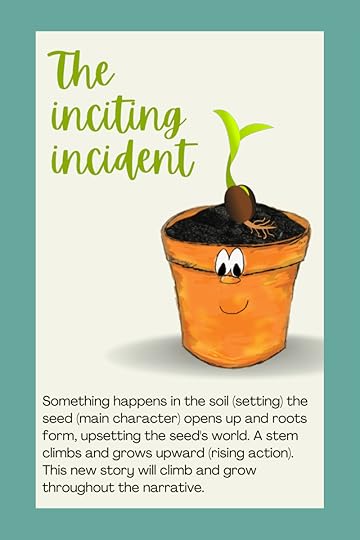 The inciting incident is the moment when the seed opens and a new story begins to grow.The elements of the story include two-fold events
The inciting incident is the moment when the seed opens and a new story begins to grow.The elements of the story include two-fold eventsAs the stem moves upward, leaves grow out of it. A leaf has two sides. As your story moves onward, events occur. Each event should have two sides too. One side should be positive and the other should be negative. Your story can have many events, just as a plant can have many leaves. However, it is good to have three main positive and negative events.
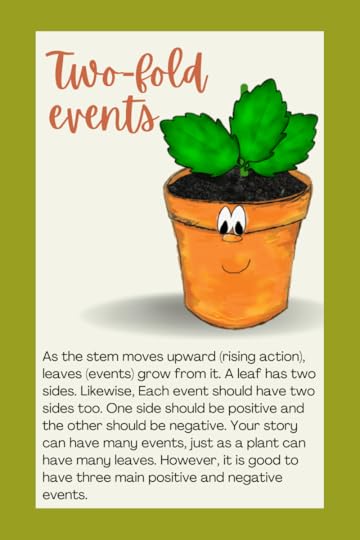 The events in the story should have a good and bad side.The climax
The events in the story should have a good and bad side.The climaxJust as the rhythm of the leaves growing seems natural, a hard receptacle forms. The receptacle is not pretty and will require a natural phenomenon to open. The same will grow within your story. The rhythm of events is moving and then suddenly your character must face the hardest crisis of all. This is the point where your reader believes all is doomed to fail unless a miracle happens. They cannot stop reading now because they must see how the character will get through this.
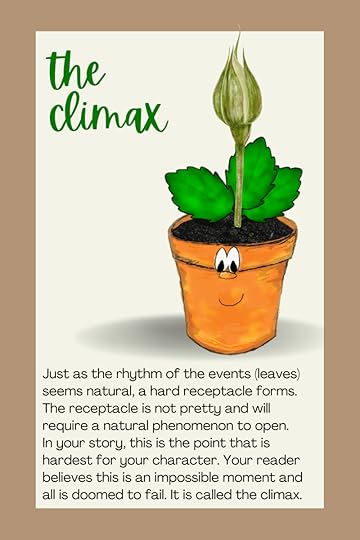 The climax is like the receptacle of the plant.An unexpected surprise
The climax is like the receptacle of the plant.An unexpected surpriseUnexpectedly, the receptacle opens and births a flower. Just as all seems lost, something unexpected unfolds in your story. Therefore, your narrative opens to birth a new and beautiful outcome. This event should surprise your readers. Likewise, your character gets help from an unexpected source. It may be that another charcter who your reader thought was gone forever comes back to save the day. Whatever it is, it should be a flowery and beatiful moment of the story.
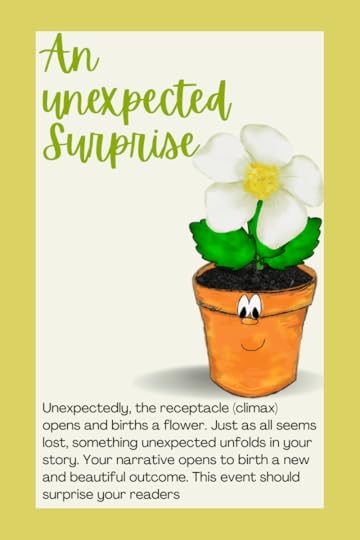 Unexpectedly the receptacle opens and births a flower.A fruitful lesson learned
Unexpectedly the receptacle opens and births a flower.A fruitful lesson learnedIt’s not over just yet. In addition., that beautiful flower will turn to fruit and produce new seeds. Both the hidden and obvious needs you identified at the beginning of your story should be met. Likewise, your character has grown and is now birthing an outcome that can produce a whole new story.
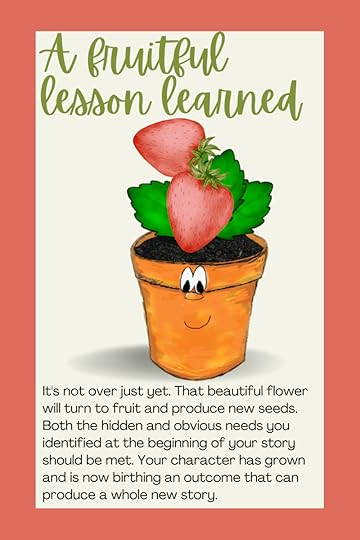 The elements of the story should include a fruitful ending.Elements of the story worksheet
The elements of the story should include a fruitful ending.Elements of the story worksheetIf you enjoyed reading about how the elements of the story connect to growing a plant, you will enjoy getting a copy of our elements of the story worksheet and presentation. Likewise, Dawn loves to visit schools and teach these steps herself. This writing workshop can be incorporated into an author visit for students too.
Little Pot is not only great at growing stories. It also demonstrates a model for growing the fruit of the Spirit. Why not join the potter and his vessels on their fruit-bearing journey? Just put in your first name and email below so we can send you the steps to becoming a fruit-bearing vessel. You will also get a fruitful Friday email each week with ways to be even more fruitful!
 Learn how the potter grows the fruit of the Spirit through you.
Learn how the potter grows the fruit of the Spirit through you.You can purchase signed copies of these books from our store. The books are also available on Amazon.
If you prefer to buy the entire set as a signed copy, go here. If you would like to schedule Dawn for a speaking engagement or author visit, go here.
The post How Elements of the Story Grow like Little Pot appeared first on Inspirational Children’s Books & Creative Teacher Resources.
July 18, 2022
Five Things we can Learn from Rocks of the Bible
The rocks of the Bible have a lot to say. In addition, children love collecting rocks, painting them, and even keeping them as pets. Did you know you can purchase a pet rock from Amazon that comes with a pet carrier and a manual telling you how to care for your pet rock. Recently, we’ve been singing a new song in church with the lyrics: “I won’t let a rock cry out in my place“. That song and the idea that children are fascinated by rocks got me thinking about how we can learn something from the rocks of the Bible.
the rocks cry out scriptureIn Luke 19:39-40 the people are shouting Hosanna to Jesus. Consequently, the Pharisees asked Jesus to tell the crowd to stop calling Him King and Lord. Jesus responded and said, “If they keep quiet the stones will cry out”. Therefore, our first lesson from a rock is that we are to worship and claim Jesus as King. Psalm 66:4 says that all creation sings praises to God. In addition, it might be fun to take a nature walk, collect a rock, then sing a worship song praising God.
lesson 1: shout hosanna and declare Jesus as your lord.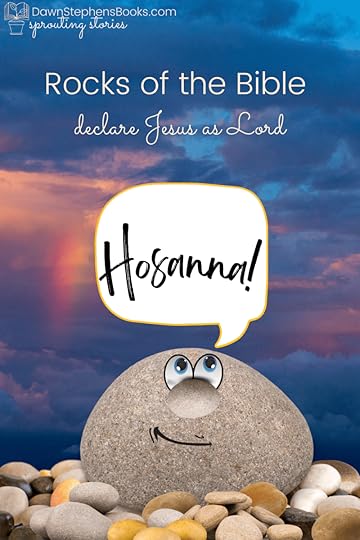 When rocks cry out scripture Luke 19:39-40 rocks of the Bible lesson 2: be kind!
When rocks cry out scripture Luke 19:39-40 rocks of the Bible lesson 2: be kind!Habakkuk 2:11 reads “Surely the stone will cry out from the wall”. This verse is a part of God’s response to Habakkuk’s concern about Babylon being used to bring justice to Israel. In the verse surrounding this text, God is explaining the tragedies or woes of a corrupt nation. In essence, if we greedily build our lives and homes at the expense of others, the very stones will cry out from the walls accusing us. Therefore, we need to consider if we are putting down others to build ourselves up. Consequently, the second thing we learn from rocks is to be kind.
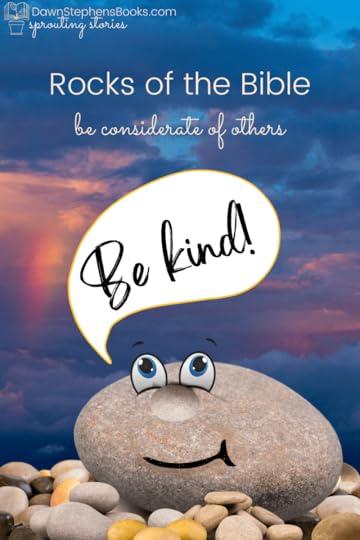 The rocks we build with will accuse us of being unkind. Habakkuk 2:11lesson 3: your faith is more important than your works
The rocks we build with will accuse us of being unkind. Habakkuk 2:11lesson 3: your faith is more important than your worksRomans 3:30-32 talks about how the law of the Old Testament was a stumbling stone for Israel. They pursued through works instead of faith. We can do the same with our religion today, serving the institution of “church” over Christ and His body. The Message Bible says it this way: “They were so absorbed in their God projects that they didn’t notice God right in front of them, like a huge rock in the middle of the road. And so they stumbled into him and went sprawling”.
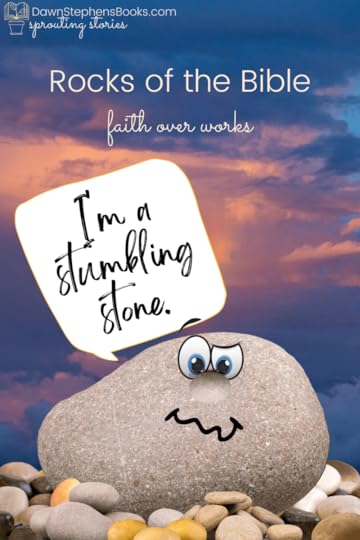 Our works can be a stumbling stone when they become more important than our faith. Rom. 3:30-32rocks of the Bible lesson 4: God provides
Our works can be a stumbling stone when they become more important than our faith. Rom. 3:30-32rocks of the Bible lesson 4: God providesGod miraculously provides water from a rock as described in Exodus 17:6, Numbers 20:8-9, and Deuteronomy 8:15. Moses got water from a rock twice in scripture. Bible scholars say this is not just about literal refreshment for the Israelites. It is further explained in 1 Corinthians 10:1-5. Within these verses, the Rock is Christ and the water represents spiritual blessings. Therefore, the third lesson is that God provides all that we need.
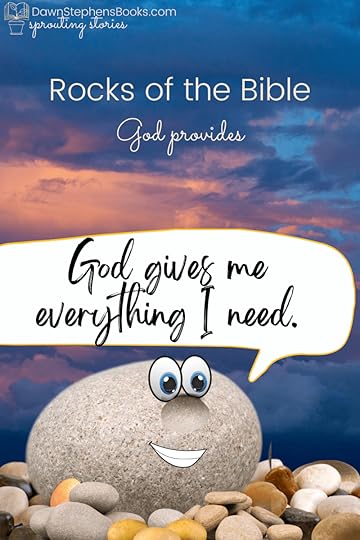 God provided water from a rock and gives life through Jesus 1 Cor. 10:1-5.rocks of the Bible lesson 5: remember all that God has done
God provided water from a rock and gives life through Jesus 1 Cor. 10:1-5.rocks of the Bible lesson 5: remember all that God has doneRocks are used to remember the good things God does for us. In Genesis 28:10-22, Jacob used a stone for a pillow. As he slept, he heard a promise of God’s protection and blessing. He then stood the pillow rock up as a memorial. Later in scripture, God parts the Jordan river so the twelve tribes of Israel into the promised land (Joshua 4:1-8). They each take a stone from the riverbed and erect a monument to remember how God took care of them. Finally, Samuel set up a stone to remember how God gave them victory over the Philistines (1 Samuel 7:7-12).
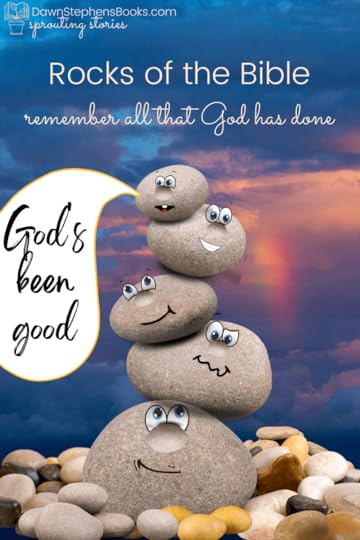 We use stones to remind us of God’s goodness. Gen. 28:10-22, Joshua 4:1-8, 1 Samuel 7:7-12.fruit of the Spirit rocks
We use stones to remind us of God’s goodness. Gen. 28:10-22, Joshua 4:1-8, 1 Samuel 7:7-12.fruit of the Spirit rocks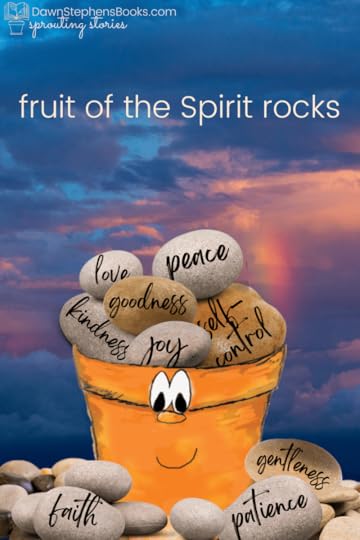 Paint the fruit of the Spirits on rocks to help you remember God’s gifts. Gal. 5:22-23
Paint the fruit of the Spirits on rocks to help you remember God’s gifts. Gal. 5:22-23Because Little Pot is all about growing the fruit of the Spirit, you might want to make some fruit of the Spirit rocks. Just choose eight stones and paint the words: love, joy, peace, patience, kindness, goodness, faithfulness, and self-control on each one. You can keep them inside your own little pot and they can remind you to be fruitful every day. Then put in your first name and email so we can send you those seven steps to becoming a fruit-bearing vessel. You will also get a fruitful Friday email each week with ways to be even more fruitful!
 Learn how the potter grows the fruit of the Spirit through you.
Learn how the potter grows the fruit of the Spirit through you.You can purchase signed copies of these books from our store. The books are also available on Amazon.
If you prefer to buy the entire set as a signed copy, go here. If you would like to schedule Dawn for a speaking engagement or author visit, go here.
The post Five Things we can Learn from Rocks of the Bible appeared first on Inspirational Children’s Books & Creative Teacher Resources.
July 11, 2022
Water in Three States of Matter with Jack and Jill
Jack and Jill go up a hill and discover water in three states of matter. They learn that H2O comes in different substances. As they climb a very big hill, they do not find water. Instead, they collect ice and snow.
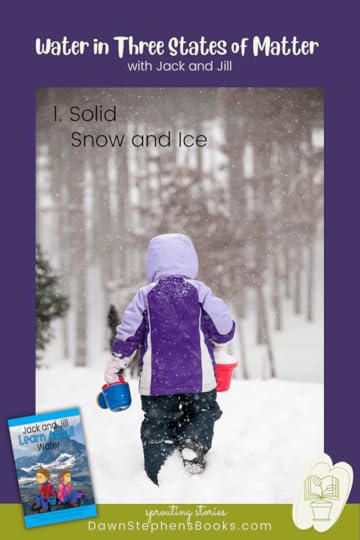 Water or H2O can be solid when it is ice and snow.
Water or H2O can be solid when it is ice and snow.When water is in the solid state, the H2O molecules are packed together. They are fixed and cannot move. This is why solids have their own shape. Freezing ice cubes in different shape containers will help a child to see that once the water becomes solid, the shape will not change.
Water in three States of Matter – LiquidAs Jack and Jill return from the mountain top with their pails, the temperature gets warmer, and the state of matter changes. The substance now turns into a liquid form. This is the most common form of H2O and therefore, is simply called water.
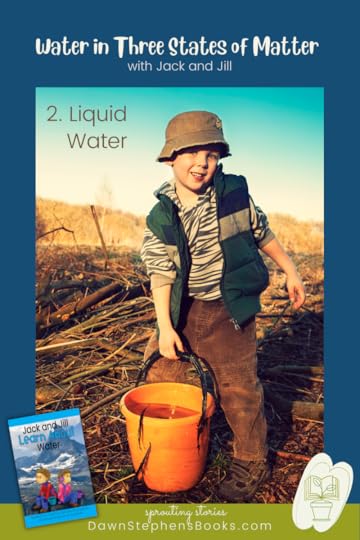 When H2O is in the liquid state, we call it water.
When H2O is in the liquid state, we call it water.In the liquid state, the molecules are packed together and move freely. When children are playing in a pool or pouring water, talk with them about how the liquid moves. It will take the shape and fill whatever container it is in. Similarly, if it does not have a container, it moves freely. This can occur if they spill their water.
Water as a Gas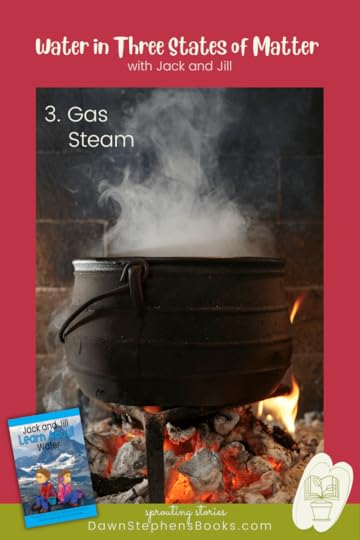 When H2O is heated, it will boil and become steam.
When H2O is heated, it will boil and become steam.Jack and Jill then take their pail of water and put it over a fire. Consequently, the temperature increases even more. The liquid boils and turns to a gas state. We call this steam.
When water is in the gas state the molecules separate even more and fly around very fast. Boiling water and watching the steam rise will help the child see water in this state. Humidifiers can also be a great way to show children what the gas state of water looks and feels like.
You can read more about how to teach water in the three states of matter here.
Jack and Jill Resources that teach about water in the 3 states of matterThe nursery rhyme of Jack and Jill is a great way to teach about water in the three states of matter.
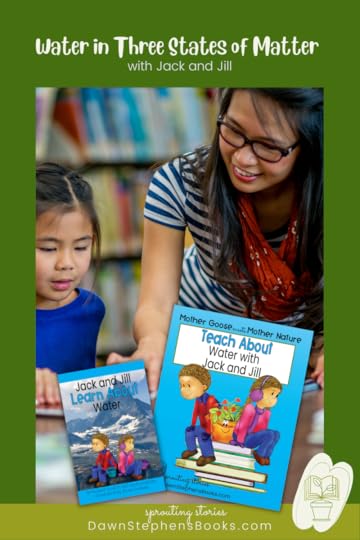 Jack and Jill Learn About Water and Teach About Water with Jack and Jill are great resources to use.
Jack and Jill Learn About Water and Teach About Water with Jack and Jill are great resources to use.In these creative teaching resources by Dawn Stephens Books, your preschoolers, kindergarteners, or first-grade students learn about the three states of matter. Dawn Stephens has masterfully created a resource that contains new lyrics to the Mother Goose rhyme of Jack and Jill. Your students will memorize the text with ease and then be able to track the words in the book. Therefore, this printable guided reading book and PowerPoint eBook Show will help students learn to read too. You can purchase it here or in our TpT store.
A teacher’s guide that incorporates spiritual, social, and academic growth is also available. This guide will provide you with worksheets and activities that go along with the lessons on the three states of matter. You can purchase the guide here.
And if you want to learn more about how all our resources grow the fruit of the Spirit, sign up for the seven steps to becoming a fruit-bearing vessel like Little Pot.
Be a fruit Pot like Little PotUnderstanding how God uses us to produce the fruit of the Spirit is important. That is why Little Pot and I have come up with a seven-step process that will allow the potter to grow love, joy, peace, patience, kindness, goodness, faithfulness, and self-control through you. Just put in your first name and email so we can send you those seven steps. Then you’ll get a fruitful Friday email each week with ways to be even more fruitful!
 Learn how the potter grows the fruit of the Spirit through you.
Learn how the potter grows the fruit of the Spirit through you.You can purchase signed copies of these books from our store. The books are also available on Amazon.
If you prefer to buy the entire set as a signed copy, go here. If you would like to schedule Dawn for a speaking engagement or author visit, go here.
The post Water in Three States of Matter with Jack and Jill appeared first on Inspirational Children’s Books & Creative Teacher Resources.

